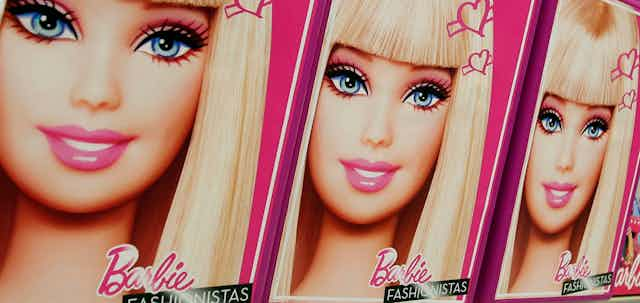The explosive public response to the upcoming Barbie movie starring Margot Robbie and Ryan Gosling demonstrates the sheer power of nostalgic marketing for contemporary consumers.
The Barbie movie made headlines last summer over its hefty US$100 million budget. Part of this budget went into its decadent set, which reportedly contributed to a global shortage of pink paint, as well as a massive marketing push that has seen partnerships with Airbnb, Xbox, Forever 21 and a multitude of other brands in numerous sectors.
Branded characters and mascots like Barbie are tied to powerful childhood memories for many. Yet in the age of the metaverse these characters aren’t remaining dolls or television characters. They’re also becoming social media influencers.
Barbie does it for the ‘gram
Barbie was developed by Mattel in 1959 in the form we know her best — a physical doll. Since then, there have been a series of Barbie’s never-ending iterations, including in digital form.
Barbie’s virtual presence first began on PC games in the early 2000s. She now exists as a virtual persona on commonly used social media platforms. There, she interacts in real-time with followers through posts and comments.
Most notably, an animated version of Barbie began vlogging through YouTube in 2015, sharing advice about life and introducing subscribers to her closet. She also takes part in the latest trends on TikTok.
Barbie currently has 11.4 million subscribers on YouTube, 2.4 million followers on Instagram and 1.1 million on TikTok. This ranks Barbie among the most successful virtual influencers in the world.
What are virtural influencers?
Virtual influencers are computer-generated personalities who exist through social media profiles to generate followers. They act just like human social media influencers in many ways. For example, they endorse products through stylish lifestyle posts and dance in viral TikTok challenges.
Virtual influencers can make just as much money — or more — as human influencers on social media. In 2021, America’s first virtual influencer, Miquela Sousa, made around USD$11 million through brand endorsements.
Lil Miquela describes herself as a 19-year-old Brazilian robot living in Los Angeles who supports causes like climate activism and Black Lives Matter. But the company behind her creation, Brud, is tight-lipped on the creative and cultural labour that has gone into her identity and activities.
Brud generates and maintains other virtual influencers as well. In 2018, their newest launch — Bermuda, a virtual influencer presenting as a young white female Trump supporter — grew upwards of 50K followers when she “hacked” into Lil Miquela’s Instagram account and proliferated her own posts to the influencer’s audience.
The timing of this stunt was notable, as it successfully demonstrated Brud’s viral buzz-building capacities while it was working to secure funding from investors.
Research finds that these virtual characters receive almost three times more engagement than human influencers — in the form of likes, comments, shares and follows that a profile may generate through posts and videos.
They also have the potential to generate lucrative curiosity in pop culture and news media. In 2019, KFC redesigned Colonel Sanders as a “hot” 2.0 version of himself, posting on Instagram as a virtual influencer. Engagement rose exponentially.
In these ways, virtual influencers represent distinct storylines and personalities which imitate racial identities, genders, sexualities and political inclinations. Their digital activities can — and do — generate tangible income and marketing benefits for their creators without the involvement of human influencers.
When brands turn into fictional influencers
While original characters like Lil Miquela and Bermuda are used to build their own following and, in some cases, infamy, characters like Barbie and Colonel Sanders represent a unique subset of virtual influencers.
As brand mascots-turned-influencers, they have a decades-long start on representing themselves and relating to the public. Moreover, they represent a company’s messaging in the form of familiar figures.
Large conglomerates have a vested interest in turning public opinion to profit-driven objectives. As such, brand mascot-influencers take on new and highly potent forms of power to share specific messages in different ways, sometimes to entirely new generations of consumers.
Virtual characters are now paired with chatbot technology to allow more conversational and human-like dialogue. When profit and public good come head-to-head, disinformation and privacy concerns can be potential consequences of such personalized storytelling.
In South Korea, users of the visual chatbot Iruda found that their intimate statements and details were illegally saved to the chatbot’s database and recycled for other conversations, resulting in numerous privacy breaches.
Iruda, a volatile large language model AI, was characterized as a harmless and attractive young woman in her 20s who is friendly and always open for a chat.
Mattel allows users aged six and older to converse with Barbie through Amazon’s Alexa. Young users on social media apps like TikTok are also encouraged to engage with Barbie through likes and comments. A 2020 study estimated that 30 per cent of users in the United States were younger than 14. Algorithmic technologies are being marketed as friendly, familiar characters who have already established trust with young consumers.
Barbie exemplifies a growing trend of companies personifying their brand mascots as virtual influencers on social media platforms. In this form, she possesses a unique power to influence opinions, emotions and buying trends for corporate profit.
Meanwhile, there are currently no regulations which demand transparency from those who communicate on behalf of virtual influencers and guardrails in case of harmful or incorrect dialogue.
In January, Meta revealed plans to construct the first-ever ethics guideline for virtual influencers. Yet as internet researchers Tama Leaver and Rachel Berryman note, the scope of this guideline is very limited.
To account for the growing activities of virtual influencers today, greater awareness and consideration of policies which govern virtual influencer creation and activity production — particularly for those with deep storylines from the analog age — are essential.

